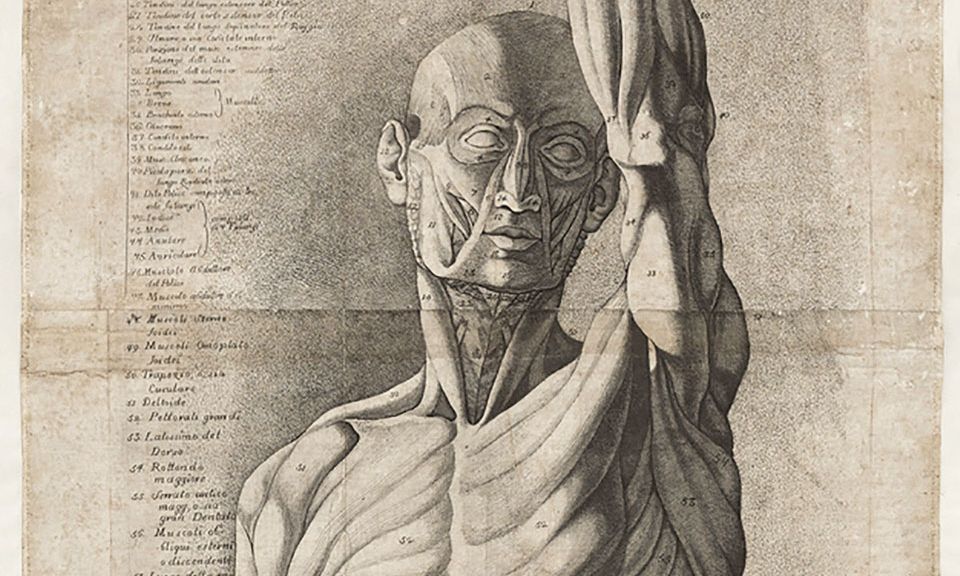Antonio Cattani (active 1777-around 1790) after Ercole Lelli (1702-66), Écorché figure (1780), etching and engraving, printed on five sheets Getty Research Institute
Exhibitions of anatomical illustrations are like packs of cards: you can shuffle the deck but eventually the same old faces (or skulls, or spleens) appear. It is to the credit of Monique Kornell, the curator of the exhibition Flesh and Bones: The Art of Anatomy at the Getty Center and lead author of the accompanying publication, that she has found some aces.
Among them are three striking life-sized intaglio prints of flayed human bodies acquired by the Getty Research Institute in 2014. The work of Italian printmaker Antonio Cattani, dating from around 1780, they depict two wooden caryatids carved by Ercole Lelli in the 1730s for the Palazzo dell’Archiginnasio in Bologna, and a composite écorché of wax over a real human skeleton made by Lelli and Giovanni Manzolini for the Bolognese Istituto delle Scienze.
Here, Kornell and her co-contributors, Thisbe Gensler, Naoko Takahatake and Erin Travers, deftly anatomise these extraordinary works, paying minute attention to their immediate production and situating them in a long-durée landscape that spans five centuries. The politics of Cattani’s prints are brought to the fore, including new details of the subscription notices issued by Cattani and his partner. These nicely illustrate two points relevant to many of the works featured in the publication.
First, they show the precarious economics of production and the balance to be struck between creating elaborate pieces to be prized by rich gentleman collectors, or sold as practical aides to impecunious artists or medical students. Second, they expose the importance of attribution and the relative weight accorded to artist and anatomist depending on the audience. Thus the fashionable Lelli’s name is prominent in Cattani’s prints, while the names of Manzolini and his partner in life and work, Anna Morandi, are absent.
The shaded borders between living and dead, anatomist and artist, past and present are recurring themes in this publication. In eight short essays (six by Kornell, one each by Gensler and Travers) and a co-authored text for the 56 exhibits, it treats such subjects as the lively disposition of figures in early modern anatomical treatises—forever strolling, sans skin, in arcadian fields, startling passersby—and the contrast in scale between the spectacular and the quotidian.
A particular delight is John Walker’s Artist’s Pocket Companion (1787), which is handily designed for the aspiring Royal Academician to slip out of view whenever Sir Joshua Reynolds—the Academy’s president and no fan of the gruesome minutiae of anatomical detail —staggered by. It also highlights the constant reworking of bodies to manufacture reputation as well as knowledge, as with the limbless marble torsos of antiquity, redrawn with added viscera for the arch self-promoting anatomist, Andreas Vesalius (1514-64), and subsequently republished with updated livers-and-lights by many of his successors.
Conceptual artist Tavares Strachan’s Robert (2018), a work based in science, featuring purple and blue neon, Pyrex, transformers and medium-density fibreboard box Collection of the artist
Alongside a strong, if familiar, selection of mostly printed books, Kornell introduces some wildcards. They include Robert Rauschenberg’s Booster (1967), a life-sized “self-portrait of [his] inner man”, as the artist described it, which in its composite complexity echoes Cattani’s prints. More striking still is Tavares Strachan’s neon sculpture Robert (2018), part of a series of works celebrating the African American astronaut Robert Henry Lawrence Jr. It is included here without the neon script in which Strachan (b.1979) tackles head-on the racism that surrounded Lawrence before and after his death in 1967. As Gensler notes, the power in Strachan’s work comes from appropriating the visual language of anatomical illustration to challenge the erasure of those who provided its subjects. If there is one criticism to be made of this publication—and there are many virtues—it is that, in the praising of anatomists and the artists they worked with, the authors are too quick to take at face value the credit they carved from the bodies of others.
• Monique Kornell, with contributions by Thisbe Gensler, Naoko Takahatake and Erin Travers, Flesh and Bones: The Art of Anatomy, Getty Research Institute, 249pp, 163 colour illustrations, $50/£40 (hb), published 1 March 2022
• Flesh and Bones: The Art of Anatomy, Getty Center, Los Angeles, until 10 July 2022
• Simon Chaplin is chief executive officer of the charitable fund Arcadia, the former director of culture and society at Wellcome, and the director of museums and special collections at the Royal College of Surgeons of England

